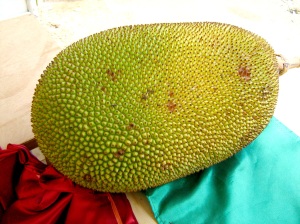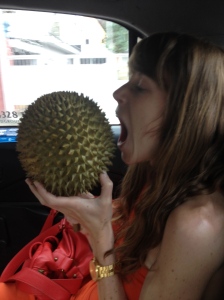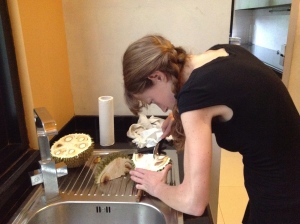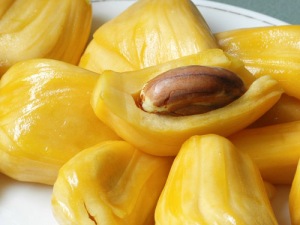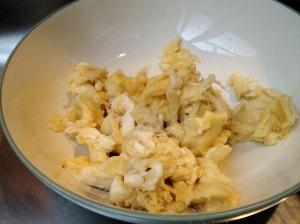As I noted earlier, I recently left Jakarta, leap-frogged through the States (on a whirlwind tour of old friends, microbrews, pretentious coffees, and artisanal cheeses that left little time for blogging–my apologies), and landed squarely in the city of Saigon. M and I got here early Saturday morning, and our first 36 hours have lived up to the expectations set by those who had been here before. Granted, Jakarta didn’t set a very high bar, but I feel like our quality of life here will be a vast improvement over that of our first Asian home. To craft a completely unjustified hypothesis based on one example, and possibly set myself up for unmet expectations, let me state the following:
My journey to Jakarta was easy, seamless, and felt far shorter than the 30 hours it actually took.
Living in Jakarta was a stressful, sometimes depressing, and physically and emotionally taxing experience.
My trip out to Saigon was a stressful, sometimes depressing, and physically and emotionally taxing experience.
Therefore: Living in Saigon will be AWESOME!!!
Q.E.D.
I will spare you the banalities and small hiccups that made my transit to ‘Nam more horrendous than one would imagine it would normally be, but will zero in on one incident, perhaps the most notable debacle of the adventure. Here goes.
Because of various planning snafus, financial limitations, and other circumstances beyond my control, during my layover in Singapore, I needed to collect my bag, go through customs and immigration, and then re-check my bag on a separate reservation on a different airline to fly to Saigon. I anticipated this process to be annoying, given the myriad steps and the fact that it would be happening in the middle of the night after 25-odd hours of travel, but I’m a pro at handling annoying, Ain’t no thang. This, however, was a thang. A very shitty thang.
Approaching baggage claim, I spotted my suitcase from afar. “Sweet!” I thought. “Easy peasy!” I raced over and yanked it off the conveyer belt, then immediately noticed that not only did the suitcase look slightly different, but it also had a tag on it saying, let’s just say, “John Generic Person,” which, I observed, is not my name. I hefted it back up onto the belt and waited for my rightful suitcase to come out. And waited. And waited.
It never came.
I went to the Lost & Found, where a gentleman with very limited English had me fill out a missing luggage form. I tried to explain to him that I was fairly certain that Mr. John Generic Person l had mistakenly taken my bag, and asked if–since not that much time had passed since our flight landed (though it was rapidly slipping through our fingertips, I silently noted), and John GP might still be in the airport–we could perhaps page him and avert the impending disaster. The man rolled his eyes and shook his head and, muttering words I did not understand, pushed the form back to me. I tried not to burst into tears right then and there (I hadn’t slept in several days, mind you), and finished filling out the form as best I could. Of course, I had neither an address nor a phone number to write down, and was imminently leaving Singapore for a city 700 miles away, so I did not harbor much hope for the return of my suitcase. My confidence was deflated slightly more when he handed my receipt, a piece of paper with no words except my (misspelled) name and an 8-digit code on a line that asked for a 10-digit code. As he tried to shoo me out of the office, I asked for his name, so that I would have something concrete to ask for when I inevitably called from Saigon asking if my bag turned up, and had nothing to tell them except for a useless number and useless description of my suitcase. He took the paper back, shaking his head again, and scrawled two illegible words in the corner of the page.
I walked calmly out of the Lost & Found, passed through customs, found a secluded corner, and collapsed on the floor in tears.
That suitcase contained: all of my most beloved clothing; all weather-appropriate clothing for my new home; an edition of the only book that I have ever co-written and edited; Clownie, my stuffed clown that I have had since before I had hair; various prescription medications; a book that my mom made me for Christmas a few years ago that I’ve kept by my bedside everywhere I’ve lived ever since.
I was a disaster.
After crying in the corner for a while, I wandered around aimlessly. Here I will mention that my flight had arrived at just past midnight, and my next flight didn’t leave until 7:20 A.M. The airport was deserted, everything was closed, and most lights were off, although the AC was going full blast. It was boring, dark, empty, and freezing. Eventually, I steered my mind toward an aim: finding a power outlet. I walked with my 50-lb backpack and 40-lb handbag (this situation was shitty enough that I’m allowing myself a little hyperbole) for about 40 minutes before I found the one outlet in the Changi airport, in the corner of a Coffee Bean & Tea Leaf, where a teenage girl was posted up with several stacks of paper and a pile of books, charging her iPhone. I turned around and wandered for perhaps another 40 minutes. Upon return, the girl was still there, still charging her iPhone, and I decided I would test my laptop’s battery and just turn it on unplugged. I sat down and fired off a tragic and perhaps slightly melodramatic e-mail to my mom, a less melodramatic e-mail to M, and a rage-filled e-mail to United, then, glancing with disdain at the iPhone-charging teenager, hauled up my stuff and commenced my aimless wandering. Five hours to go.
I meandered past closed airport restaurants and deserted ticketing counters, pausing to sob on a few benches and to exchange some U.S. dollars for Vietnamese dong (ha!). As it turns out, aimless wandering at 3 in the morning with two heavy bags gets old quick, and so I found myself back at the Coffee Bean about half an hour later. I checked my e-mail again, and saw a new message from my dad, titled “your bag.” I assumed my mom had told him about the e-mail she’d received from me, and that he was offering his condolences, and looked at a few other emails before opening his. When I finally did, my heart briefly stopped. “Kate,” it read. “I know you couldn’t find your bag–another person picked it up by mistake and contacted me about an hour ago from his Singapore hotel. I gave him your information, and he arranged for United to take your bag back to the airport…it should be there about an hour from now.” At this point, I cried again. Then I checked the time stamp on my dad’s e-mail, which showed that I had a mere 20 minutes until my bag would allegedly arrive. I used this time to write a non-tragic but equally melodramatic e-mail to my parents, and to cry some more. Then I strapped up and headed to the Lost & Found.
The rest of the tale is fairly uneventful, so I’ll skip the details and give you a brief rundown. I sweet-talked my way backwards through customs, showed up at the Lost & Found, collected my bag, went back through customs, forwards this time, and then headed to my flight.
What I will elaborate on a bit is this: Check the goddamn tags on the bag you pick up from baggage claim, John Generic Person. And everyone else. JGP, I know that you flew from New York to Singapore, which can mean few things other than that you work at a place like JP Morgan or something else that makes you lots of money and makes you feel super important. But you’re not too important to look at goddamn luggage tags. I know that you’re the type of guy who doesn’t look at his bag at all until he’s about to unpack in your (presumably very swanky) hotel in downtown Singapore, and that is likely because you had paid caddies handling your bag all the way from baggage claim to hotel bedside. But it’s not your caddies responsibility to check the goddamn luggage tags. I know that you’re a big jerk and you made me cry an unhealthy amount in a short period of time, causing the 6 people at the Changi airport between 1 and 4 a.m. that night to have less than favorable impressions of me. So don’t assume that every generic blue roll-on suitcase is yours. Because it’s not. There are probably quite a few of them in the world, and now we have confirmation that there are at least two.
I hope you enjoy your stay in Singapore, with your own possessions now safely restored to you. Because you would have looked pretty dumb wearing my new blue tube dress, and Clownie does not take well to strangers.


